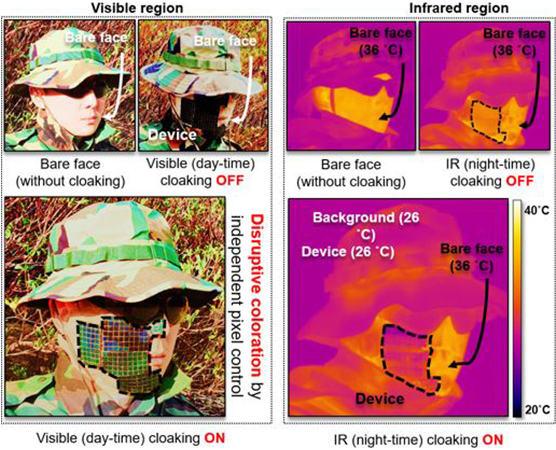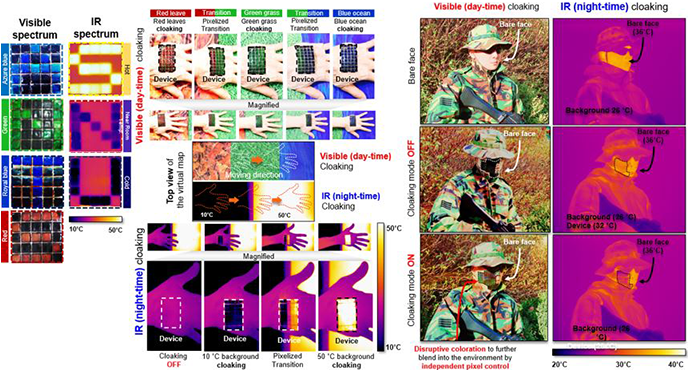Biometrically disguised to become completely undetected in the visible-to-infrared range
Anticipated to significantly contribute to pixelation, diverse means of visualizing colorization as well as to the defense industry

From left, Professor Seung Hwan Ko of the Applied Nano and Thermal Science (ANTS) Laboratory, Ph.D. students Jinwoo Lee and Heayoun Sul
A research team led by Professor Seung Hwan Ko of the SNU College of Engineering has developed a technology reminiscent of invisibility suits that were commonly seen in science-fiction films such as "Ghost in the shell."
Professor Ko's research team, the Applied Nano and Thermal Science (ANTS) Laboratory announced on November 10 of its development of an electronic skin that can actively camouflage in the visible-to-infrared (visible-to-IR) light range. The device can be attached to the skin and adjusts color or temperature with electrical signals to adapt to the outside environment during the day or night to help with camouflaging against the human eye or infrared cameras.
In nature, some animals adaptively camouflage themselves to the outside environment, increasing their chances of survival through subsequent escape from predators or by deceiving their prey. Cephalopods such as squids and octopi are such examples. Nano-meter pigment particles in cephalopod skins can be completely camouflaged to the external environment by rearranging the distance between pigmented particles to reflect visible light or infrared wavelengths as needed.
Professor Ko's research team took notice of such superior camouflaging capabilities of these cephalopods. While there is extensive research currently being carried out in the defense industry on camouflage or stealth technology to remain undetected by the enemy, the only way to do so was the conventional use of camo-patterned fabric in military uniforms. However, since camouflage patterned fibers are incapable of active camouflage, they are easy to be noticed when in motion, or in a complex patterned environment.
The researchers developed a flexible and soft thermal electric device that can be attached to the skin, which can also quickly be cooled or heated to adjust the temperature to the suit's external environment, enabling disguise from thermal cameras within the infrared band range. Furthermore, thermochromic liquid ink, which can be freely discolored according to temperature, was applied on a flexible thermochromic device to enable the element to implement various colors.

When wearing the camouflaging electronic skin during the day, the color changes depending on the external environment so that one's location is not exposed to the enemy, while at night, the temperature of the electronic skin can be adjusted to the outside temperature.
Here, a thermal electric device refers to a device that can be absorbed or heated according to the direction of the current using the Peltier Effect.
When a thermoelectric device supplies voltage to a structure with many negative and positive charges connected in series, the charge carrier is momentarily aligned in one direction, cooling one side of the element and heating the other side. When the current of the charge is made to flow to the opposite direction, the cooling/heating surface switches. This means that cooling/heating can be fine-tuned depending on current direction and voltage.
This is the Peltier principle, and using this, the research team has achieved the free and flexible change in the surface temperature and color of the thermal electric device to allow camouflage in the visible-to-infrared range. This means that they can disguise themselves, regardless of whether it is day or night.
The researchers also "pixelated" the surface of the camouflaging electronic skin, allowing only a few pixels to locally heat and cool. As a result, a device that can independently activate thermoelectric pixels to transmit information like a display, or that can camouflage in real-time under visible or infra-red light bands even when moving in a complexly-patterned environment, was manufactured as shown in the diagram below.

By "pixelating" the camouflaging electronic skin, each and every pixel can disguise itself as fit to the external environment in real-time, which means it can be camouflaged even if it is in a complex external environment or if one's position is changed.
This camouflaging electronic skin device can be useful for the defense industry. The researchers demonstrated the camouflaging skin themselves by attaching the device to their skin and demonstrated that it was possible to camouflage without any issues during the daytime, nighttime, changes in ambient temperature or in complex leaf-filled environments, as shown in the picture above.
"The camouflage technology is a very important factor in military contexts that increases one's survival rate by preventing one from being detected by the enemy. We expect the research to directly contribute to our defense industry," said Professor Ko.
The research findings were published online in the world-renowned journal in the field of Material Science <
Advanced Functional Materials> on July 14.
Meanwhile, the research was supported by the Korea Research Foundation's Basic Support Project, Mid-Career Researcher Support Project, and the Leading Research Center Project.
For further information, please contact Prof. Seung Hwan Ko.





